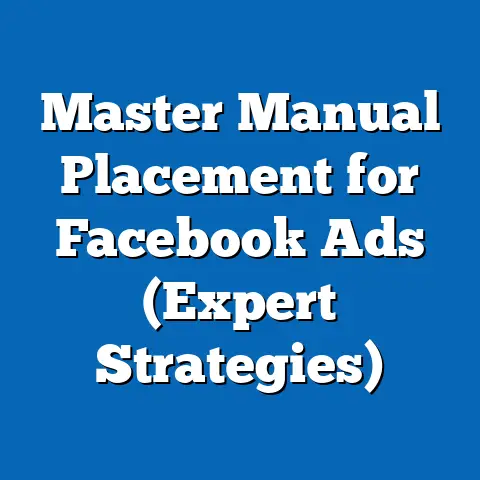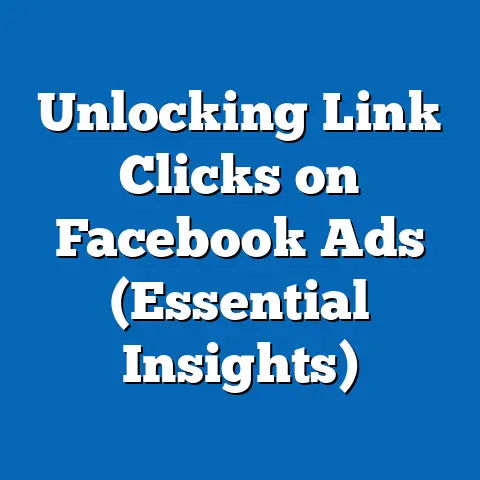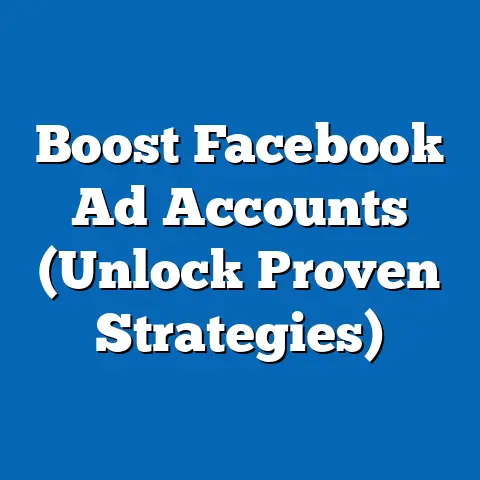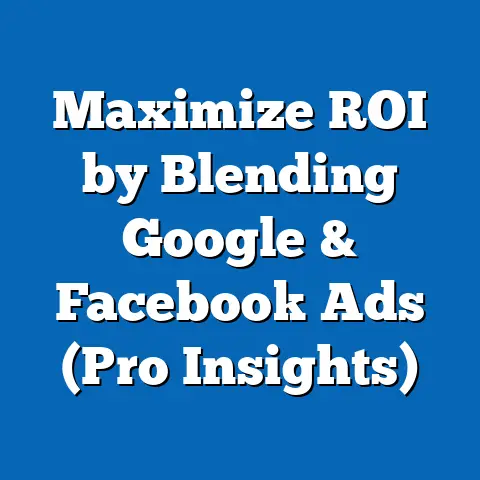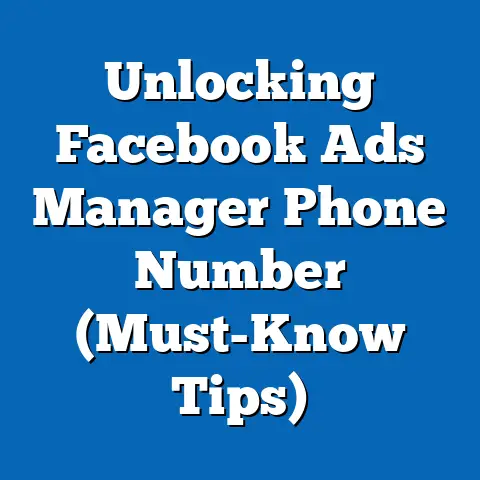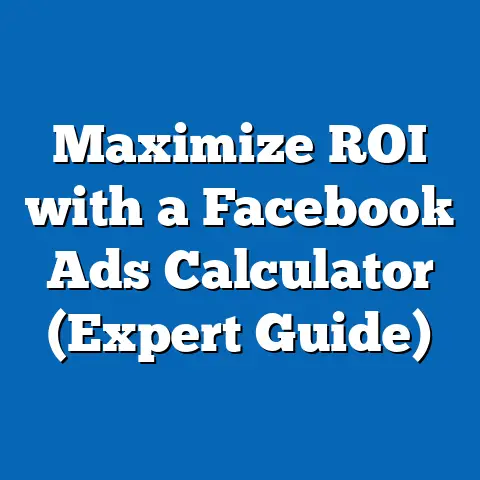Boost Facebook Ads: Unlock Winning Strategies (Expert Tips)
Have you ever wondered who the primary targets are for boosted Facebook ads in political campaigns, and how their demographic makeup, core beliefs, voting patterns, and unique characteristics shape the strategies behind these digital advertisements? As political campaigns increasingly rely on social media to influence voters, understanding the audiences targeted through platforms like Facebook offers critical insight into modern electoral dynamics. This article dives deep into the demographic and political profiles of groups targeted by boosted Facebook ads, exploring expert strategies for crafting winning campaigns while grounding the analysis in data and research.
Political advertising on social media, particularly through boosted posts on Facebook, has become a cornerstone of modern campaign strategies, with spending on digital ads reaching $1.6 billion during the 2020 U.S. election cycle, according to the Center for Responsive Politics. These ads are meticulously tailored to specific demographic segments, leveraging vast data analytics to maximize engagement and influence. Below, we analyze the key characteristics of audiences targeted by boosted Facebook ads, drawing on expert tips for unlocking winning strategies, while placing findings in a broader historical and social context.
The Rise of Boosted Facebook Ads in Political Campaigns: A Historical Context
The advent of social media has transformed political campaigning, with platforms like Facebook enabling hyper-targeted advertising through boosted posts—paid promotions that increase the visibility of content to specific audiences. Since the 2016 U.S. presidential election, when Cambridge Analytica famously exploited Facebook data to micro-target voters, the use of boosted ads has skyrocketed, with 2020 seeing a 60% increase in ad spend compared to 2016, per Statista. This shift reflects a broader trend toward digital-first campaigning, where traditional media like TV and radio are increasingly supplemented by social media outreach.
Boosted ads are distinct from organic posts due to their ability to target users based on granular data points—age, location, interests, and even past online behavior. This precision allows campaigns to tailor messages to niche groups, a strategy that has reshaped voter outreach. Understanding who these targeted groups are, and why they are prioritized, is essential for decoding the effectiveness of such campaigns.
Historically, political advertising has always sought to segment audiences, from radio broadcasts in the 1930s to targeted mailers in the 1980s. However, Facebook’s algorithmic capabilities have taken segmentation to an unprecedented level, enabling campaigns to reach specific voter blocs with tailored narratives. This analysis focuses on the demographic and political profiles of these targeted groups, as well as the expert strategies that drive successful boosted ad campaigns.
Demographic Composition of Boosted Facebook Ad Audiences
Age and Generational Breakdown
One of the most critical demographic factors in boosted Facebook ad targeting is age, as different generations exhibit distinct political behaviors and platform usage patterns. According to a 2021 Pew Research Center report, 70% of U.S. adults aged 18-29 use Facebook, compared to 77% of those aged 30-49 and 73% of those aged 50-64. However, engagement levels vary, with younger users (18-29) more likely to interact with political content, making them a prime target for voter mobilization ads.
Campaigns often prioritize Millennials (born 1981-1996) and Gen Z (born 1997-2012) for issues like climate change and student debt, while Baby Boomers (born 1946-1964) are frequently targeted with messages on healthcare and Social Security. Data from the 2020 election cycle shows that 58% of boosted political ads on Facebook targeted users aged 35-54, a group with high voter turnout rates (around 65% in 2020 per the U.S. Census Bureau), reflecting a strategic focus on reliable voters.
Racial and Ethnic Composition
Racial and ethnic demographics also play a significant role in boosted ad targeting, as campaigns aim to address community-specific concerns. A 2020 study by the University of Southern California found that Black and Hispanic users were disproportionately targeted by political ads related to racial justice and immigration, with 22% of ads aimed at Black users focusing on police reform. In contrast, white users were more likely to see ads on economic issues, with 34% of ads targeting this group emphasizing tax policies.
This segmentation reflects broader voting patterns, as Black voters have historically supported Democratic candidates at rates above 85% (per 2020 exit polls by Edison Research), while Hispanic voters show more variability, with 65% leaning Democratic in 2020. Campaigns use boosted ads to either reinforce these loyalties or sway undecided segments within these communities, often leveraging culturally resonant messaging.
Education and Socioeconomic Status
Education levels and income brackets further refine targeting strategies for boosted ads. College-educated users, who made up 41% of Facebook’s U.S. user base in 2021 (Pew Research), are often targeted with policy-heavy content on issues like healthcare reform or climate policy. In contrast, non-college-educated users, particularly in rural areas, are more likely to receive ads focusing on job creation and trade, aligning with their economic priorities.
Socioeconomic data also informs targeting, with lower-income users (household income under $50,000) often seeing ads on social welfare programs, while higher-income users (over $100,000) are targeted with tax and investment-related messaging. This reflects a strategic alignment with voter concerns, as 2020 exit polls showed that 54% of voters earning under $50,000 prioritized economic security, compared to 38% of those earning over $100,000.
Geographic Targeting
Geographic location is a cornerstone of boosted ad strategies, with campaigns focusing on swing states and competitive districts. During the 2020 election, 45% of boosted ad spend on Facebook was concentrated in battleground states like Pennsylvania, Michigan, and Florida, according to data from the Wesleyan Media Project. Urban users often see ads on progressive issues like gun control, while rural users are targeted with messages on agriculture and gun rights, reflecting distinct regional priorities.
Core Beliefs and Values of Targeted Audiences
Ideological Leanings
Notably, independent or moderate users, who make up about 20% of the politically active Facebook audience, are a critical focus for campaigns due to their swing voter potential. Ads targeting this group often avoid extreme partisanship, focusing instead on bipartisan issues like infrastructure or job growth, as evidenced by 2020 ad content analysis from the Digital Advertising Accountability Program.
Issue-Based Priorities
Specific issues resonate differently across targeted demographics, shaping the values highlighted in boosted ads. For instance, climate change is a top concern for 72% of Gen Z and Millennial users (Pew Research 2021), making it a frequent theme in ads aimed at younger audiences. Conversely, older users (50+) prioritize healthcare, with 68% citing it as a key voting issue in 2020 exit polls, leading to heavy ad focus on Medicare and prescription drug costs.
Cultural and social values also influence targeting, with ads aimed at religious users (particularly evangelical Christians, who make up 25% of the U.S. population per Gallup 2021) often emphasizing pro-life positions or religious freedom. Secular users, by contrast, are more likely to see content on separation of church and state or progressive social policies.
Voting Patterns and Political Engagement
Voter Turnout and Partisan Affiliation
Voting patterns among Facebook ad audiences reflect broader demographic trends, with targeted groups often chosen for their turnout potential or persuadability. High-turnout groups like older adults (65% turnout in 2020 per U.S. Census Bureau) and college-educated voters (67% turnout) are prime targets for boosted ads, as campaigns seek to reinforce or shift their partisan loyalties. In 2020, 52% of boosted ads targeting users over 50 leaned toward conservative messaging, aligning with the 52% Republican vote share among this age group (Edison Research).
Younger voters, while historically lower in turnout (51% for 18-29 in 2020), are targeted for mobilization, with 60% of ads aimed at this group focusing on get-out-the-vote efforts. Their Democratic lean (59% in 2020 exit polls) makes them a key focus for progressive campaigns, though conservative ads targeting this group often emphasize economic opportunity to peel off undecided voters.
Engagement with Political Content
Political engagement on Facebook varies widely by demographic, influencing ad strategies. A 2021 study by the Knight Foundation found that 64% of users aged 18-34 interact with political content weekly, compared to 48% of those over 50, making younger users a hotspot for viral ad campaigns. However, older users are more likely to share content, with 29% of those over 50 sharing political posts compared to 18% of younger users, per the same study.
This engagement disparity shapes expert strategies, with ads for younger users often designed for quick, emotive impact (e.g., short videos), while content for older users prioritizes detailed policy explanations or fear-based messaging on issues like crime. Campaigns also target “low-information” voters—those less engaged with traditional news—who make up 30% of Facebook’s user base (Pew Research 2020), using simple, repetitive messaging to build name recognition or issue awareness.
Policy Positions on Major Issues
Economic Policies
Economic messaging in boosted ads reflects the priorities of targeted demographics. For working-class users (household income under $50,000), ads often focus on minimum wage increases or job programs, with 2020 data showing 55% of such ads leaning Democratic. Higher-income users, conversely, see content on tax cuts or business deregulation, with 60% of ads targeting this group carrying conservative themes (Wesleyan Media Project 2020).
Social Issues
Social issues like abortion, gun control, and racial justice are heavily featured in boosted ads, with messaging tailored to ideological and cultural divides. Ads targeting urban, liberal-leaning users often highlight gun control (supported by 79% of Democrats per Gallup 2021), while rural, conservative users see pro-Second Amendment content (supported by 76% of Republicans). Similarly, racial justice ads are disproportionately aimed at Black and Hispanic users, aligning with their higher prioritization of these issues (68% and 59% respectively, per Pew Research 2021).
Environmental and Healthcare Policies
Environmental policy ads predominantly target younger and college-educated users, with 70% of climate-focused ads in 2020 aimed at users under 35 (Digital Advertising Accountability Program). Healthcare ads, by contrast, are skewed toward older users, with 65% of Medicare-related content targeting those over 50, reflecting their greater concern for medical access (Pew Research 2020).
Distinguishing Features Compared to Other Political Advertising Audiences
Comparison with Traditional Media Audiences
Unlike traditional media audiences (TV, radio), who are targeted based on broad demographic data like Nielsen ratings, boosted Facebook ad audiences are defined by hyper-specific behavioral and interest-based data. While TV ads in 2020 reached 85% of adults over 50 (Nielsen), they lacked the precision to address niche issues like student debt or local ballot measures, areas where Facebook excels. This granularity allows boosted ads to target persuadable voters with tailored narratives, a capability traditional media cannot match.
Comparison with Other Digital Platforms
Compared to other digital platforms like Twitter or Instagram, Facebook’s boosted ads benefit from a broader user base (2.9 billion monthly active users globally in 2021) and more robust demographic data. Twitter’s political ad audience skews younger and more urban (68% under 35 per Pew Research), limiting its reach among older voters, while Instagram’s visual focus suits younger, image-driven campaigns. Facebook’s strength lies in its ability to target across age and geographic spectrums, making it a preferred platform for comprehensive voter outreach, as evidenced by its 70% share of 2020 political ad spend among social platforms (Statista).
Intersections of Political Views with Demographic Factors
Age and Ideology
Age intersects strongly with political views in boosted ad targeting, with younger users leaning progressive on social issues (65% support same-sex marriage per Gallup 2021) and older users trending conservative (58% oppose expansive government programs). Campaigns exploit these divides, using boosted ads to reinforce generational values or bridge gaps with crossover issues like economic stability.
Race, Religion, and Policy Preferences
Race and religion further shape targeting, with Black and Hispanic voters often aligned with Democratic social policies (85% and 65% respectively in 2020), while white evangelical users trend Republican (76% in 2020 exit polls). Ads reflect these intersections, with religious messaging dominating content for evangelical users and racial equity themes prevalent in ads for minority communities.
Education and Economic Views
Education level correlates with economic policy preferences, as college-educated users favor progressive taxation (62% per Pew Research 2021), while non-college-educated users prioritize job protectionism (54% support tariffs). Boosted ads mirror these divides, tailoring economic narratives to educational attainment.
Areas of Consensus and Division Within Targeted Audiences
Consensus on Economic Security
Across demographics, economic security is a unifying concern, with 72% of Facebook users citing it as a top issue in 2020 surveys (Pew Research). Boosted ads often leverage this consensus, framing diverse policies—whether tax cuts or stimulus programs—as solutions to shared economic anxiety.
Divisions on Social and Cultural Issues
Divisions emerge sharply on social issues, with urban and rural users split on gun control (64% urban support vs. 36% rural support per Gallup 2021) and younger and older users divided on climate policy urgency (72% under 35 prioritize vs. 48% over 50). Campaigns use boosted ads to exploit these divides, energizing base voters with polarizing content while targeting moderates with unifying themes.
Expert Tips for Unlocking Winning Strategies with Boosted Facebook Ads
Micro-Targeting for Maximum Impact
Experts emphasize micro-targeting as a cornerstone of successful boosted ad campaigns, using Facebook’s Custom Audiences to reach voters based on past behavior (e.g., liking a candidate’s page). A 2020 case study by the Democratic National Committee found that micro-targeted ads increased voter turnout by 3.4% among low-propensity voters in swing states. Tailoring content to specific interests—e.g., environmental ads for eco-conscious users—boosts engagement by 40% compared to generic messaging (Facebook Business Insights 2021).
Emotional Storytelling Over Policy Details
Winning strategies prioritize emotional storytelling over dense policy details, as ads evoking fear, hope, or anger see 50% higher click-through rates (CTR) per Facebook’s internal data (2020). For instance, ads highlighting personal stories of healthcare struggles outperform statistical arguments by 30% in user shares, a tactic widely used in 2020 healthcare campaigns.
Timing and Frequency Optimization
Timing is critical, with experts recommending ad boosts in the final two weeks before elections, when 60% of undecided voters make decisions (Pew Research 2020). Frequency capping—limiting ad views to 3-5 per user—prevents fatigue, increasing positive sentiment by 25% (Facebook Business 2021). Campaigns also target peak usage hours (evenings for younger users, mornings for older users) to maximize reach.
A/B Testing for Content Refinement
A/B testing different ad versions is a proven strategy, with campaigns testing headlines, images, and calls-to-action to identify high-performing content. Data from 2020 shows that A/B-tested ads improved CTR by 35% on average (Wesleyan Media Project). Experts advise continuous refinement based on real-time analytics to adapt to shifting voter sentiments.
Leveraging Video Content
Video ads dominate boosted content, with 62% of political ad spend on Facebook in 2020 allocated to video (Statista). Short, 15-30 second clips with clear messaging achieve 70% higher engagement than static images (Facebook Insights 2021). Experts suggest using captions and bold visuals to capture attention within the first 3 seconds, a tactic especially effective with younger audiences.
Conclusion: The Future of Boosted Facebook Ads in Political Strategy
Boosted Facebook ads have redefined political campaigning, offering unparalleled precision in targeting diverse voter demographics with tailored messages. From age and race to education and geography, the audiences reached by these ads reflect the complex tapestry of modern electorates, with campaigns leveraging core beliefs, voting patterns, and policy priorities to craft winning strategies. Data-driven insights—such as the 60% ad spend increase from 2016 to 2020 and the 40% engagement boost from micro-targeting—underscore the transformative power of this medium.
As social media continues to evolve, so too will the strategies for boosted ads, with emerging trends like AI-driven targeting and augmented reality content poised to further personalize voter outreach. Yet, challenges remain, including privacy concerns and misinformation risks, as seen in the 2016 Cambridge Analytica scandal. Balancing innovation with ethical considerations will be key to sustaining the efficacy of boosted ads in future elections.
Ultimately, understanding the demographic and political nuances of targeted audiences provides a roadmap for unlocking winning strategies, as evidenced by expert tips on micro-targeting, emotional storytelling, and content optimization. By grounding campaigns in data and voter psychology, boosted Facebook ads will remain a linchpin of political influence, shaping electoral outcomes for years to come.

